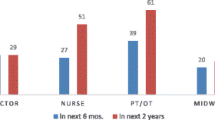Abstract
To examine the relationship between measures of state economic, political, health services, and Title V capacity and individual level measures of the well-being of CSHCN. We selected five measures of Title V capacity from the Title V Information System and 13 state capacity measures from a variety of data sources, and eight indicators of intermediate health outcomes from the National Survey of Children with Special Health Care Needs. To assess the associations between Title V capacity and health services outcomes, we used stepwise regression to identify significant capacity measures while accounting for the survey design and clustering of observations by state. To assess the associations between economic, political and health systems capacity and health outcomes we fit weighted logistic regression models for each outcome, using a stepwise procedure to reduce the models. Using statistically significant capacity measures from the stepwise models, we fit reduced random effects logistic regression models to account for clustering of observations by state. Few measures of Title V and state capacity were associated with health services outcomes. For health systems measures, a higher percentage of uninsured children was associated with decreased odds of receipt of early intervention services, decreased odds of receipt of professional care coordination, and increased odds of delayed or missed care. Parents in states with higher per capita Medicaid expenditures on children were more likely to report receipt of special education services. Only two state capacity measures were associated explicitly with Title V: states with higher generalist physician to population ratios were associated with a greater likelihood of parent report of having heard of Title V and states with higher per capita gross state product were less likely to be associated with a report of using Title V services, conditional on having heard of Title V. The state level measure of family participation in Title V governance was negatively associated with receipt of care coordination and having used Title V services. The measures of state economic, political, health systems, and Title V capacity that we have analyzed are only weakly associated with the well-being of children with special health care needs. If Congress and other policymakers increase the expectations of the states in assuring that the needs of CSHCN and their families are addressed, it is essential to be cognizant of the capacities of the states to undertake that role.
Similar content being viewed by others
References
National Research Council and Institute of Medicine. (2000). From neurons to neighborhoods: The science of early childhood development. Washington, D.C.: National Academy Press.
McPherson, M., Arango, P., Fox, H., Lauver, C., McManus, M., Newacheck, P., et al. (1998). A new definition of children with special health care needs. Pediatrics, 102, 137–139.
Maternal and Child Health Bureau (2003). Maternal and child health services title V block grant program: Guidance and forms for the title V application/annual report. Rockville, MD: MCHB.
Ireys, H., Anderson, G., Shaffer, T., & Neff, J. (1997). Expenditures for care of children with chronic illnesses enrolled in the Washington State Medicaid Program, fiscal year 1993. Pediatrics, 100, 197–204.
Centers for Disease Control. SLAITS: Children with Special Health Care Needs Module. National Center for Health Statistics http://www.cdc.gov/nchs/about/major/slaits/cshcn.htm.
Kawachi, I., Kennedy, B., et al. (1997). Social capital, income inequality, and mortality. ASPH, 87, 1491–1498.
Bird, S., & Bauman, K. (1995). The relationship between structural and health services variables and state-level infant mortality in the United States. AJPH, 85, 26–29.
Mayer, M., Clark, S., et al. (1999). The role of state policies and programs in buffering the effects of poverty on children’s immunization receipt. AJPH, 89, 164–170.
Perrin, J., Ettner, S., et al. (1998). State variations in supplemental security income enrollment for children and adolescents. AJPH, 88, 928–931.
Mayer, M., Skinner, A., & Slifkin, R. (2004). Unmet need for routine and specialty care: data from the national survey of children with special health care needs. Pediatrics, 113, e109–e115.
Blumberg, S. J., & Bramlett, M. D. (2005). Comparing states on outcomes for children with special health care needs. Maternal and Child Health Journal, 9S, S121–S128.
Margolis, L. H., Mayer, M. L., Clark, K. A., & Farel, A. (2010). The Relationship between state capacity measures and allocations to Children and Youth With Special Needs within the MCH Services Block Grant. Matern Child Health J (forthcoming).
Maternal and Child Health Bureau. Title V Information System. https://perfdata.hrsa.gov/mchb/mchreports/LEARN_More/Title_V_Information_System/title_v_information_system.asp.
Van Dyck, P. C., McPherson, M., Strickland, B. B., Nesseler, K., Blumberg, S. J., Cynamon, M. L., et al. (2002). The national survey of children with special health care needs. Ambulatory Pediatrics, 2, 29–37.
Health Resources and Services Administration (2000). Title V: A snapshot of maternal and child health 2000. Washington, D.C.: Health Resources and Services Administration.
Haley, J., & Kenney, G. (2007). Low-income uninsured children with special health care needs: Why aren’t they enrolled in public health insurance programs? Pediatrics, 119, 60–68.
Acknowledgments
This paper is dedicated to the memory of Michelle Mayer, a fine friend and exemplary scholar. We appreciate the guidance provided by Virginia Gray to enhance our understanding of the measurement of state-level capacities. This work was supported by HRSA/MCHB grant R40MC04295-01-00.
Author information
Authors and Affiliations
Corresponding author
Additional information
Michelle Mayer: Deceased.
Rights and permissions
About this article
Cite this article
Margolis, L.H., Mayer, M., Clark, K.A. et al. Associations between State Economic and Health Systems Capacities and Service Use by Children with Special Health Care Needs. Matern Child Health J 15, 713–721 (2011). https://doi.org/10.1007/s10995-010-0642-3
Published:
Issue Date:
DOI: https://doi.org/10.1007/s10995-010-0642-3




